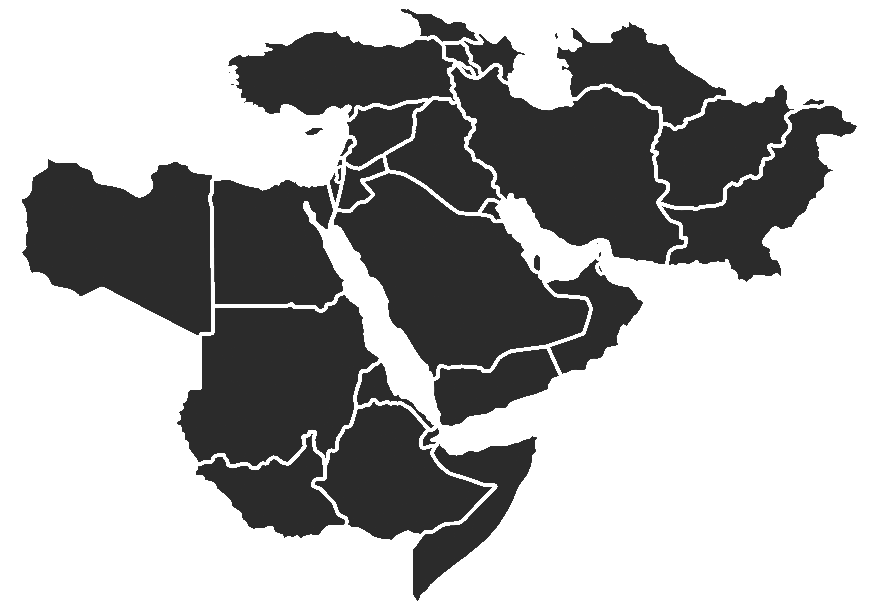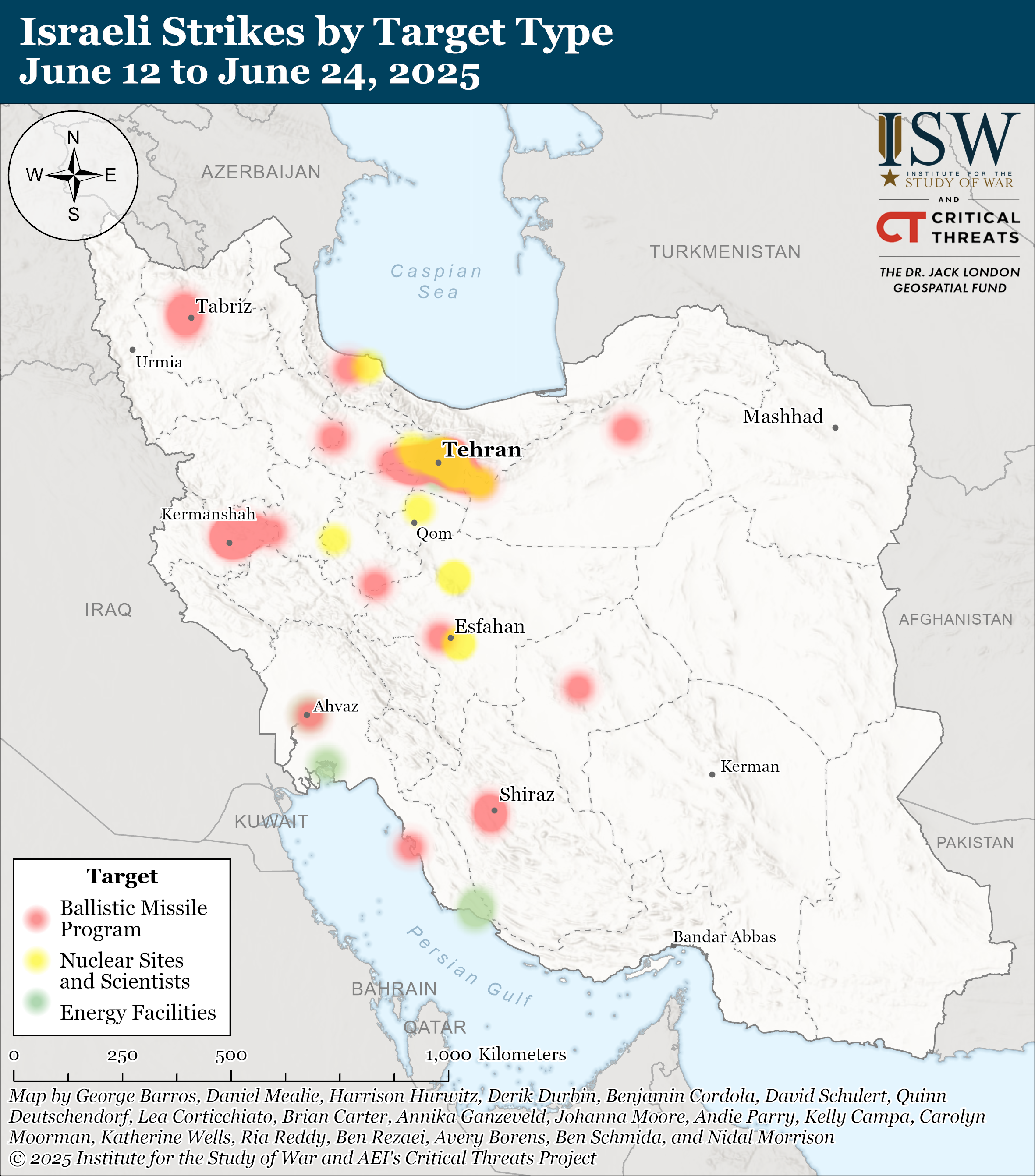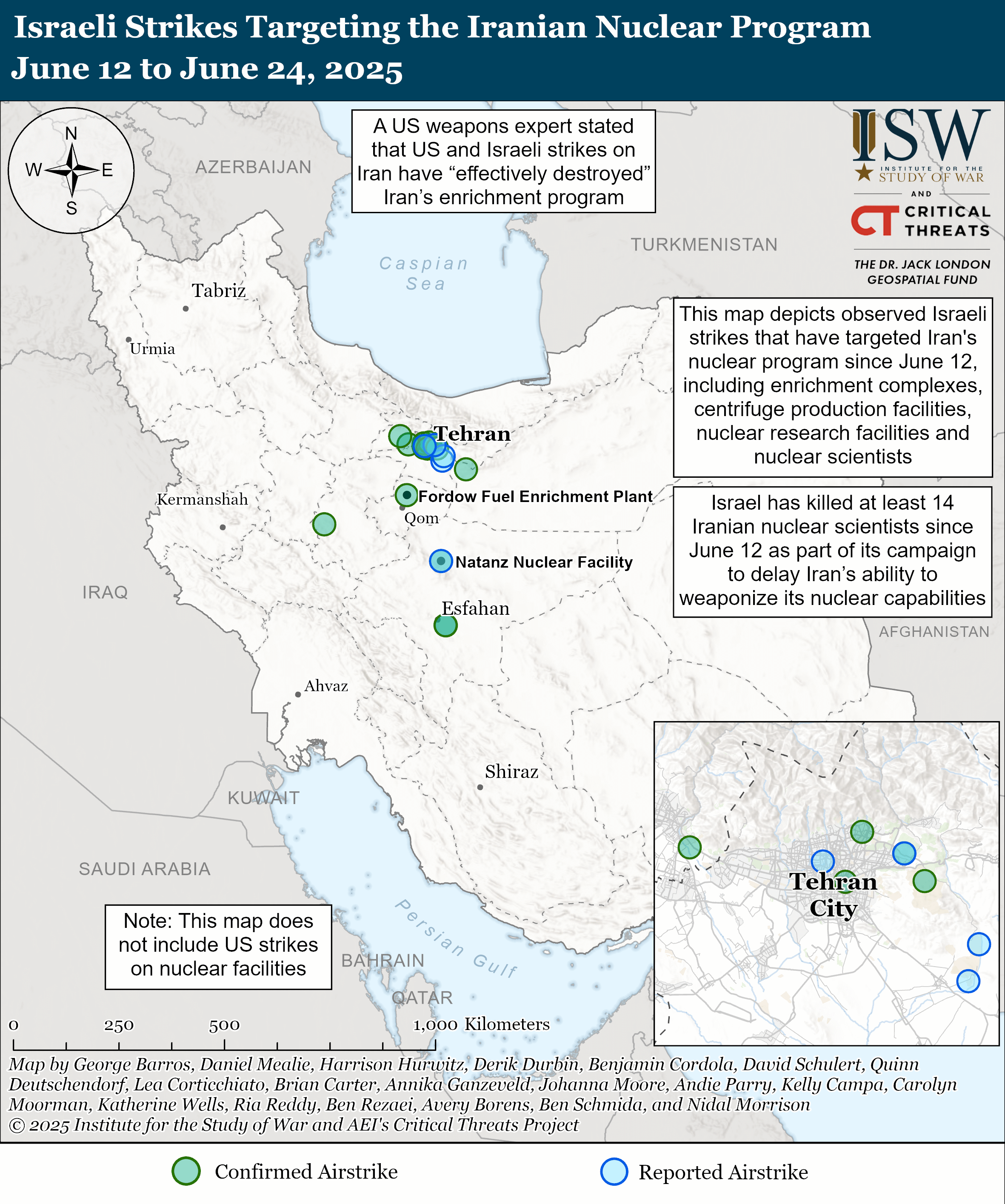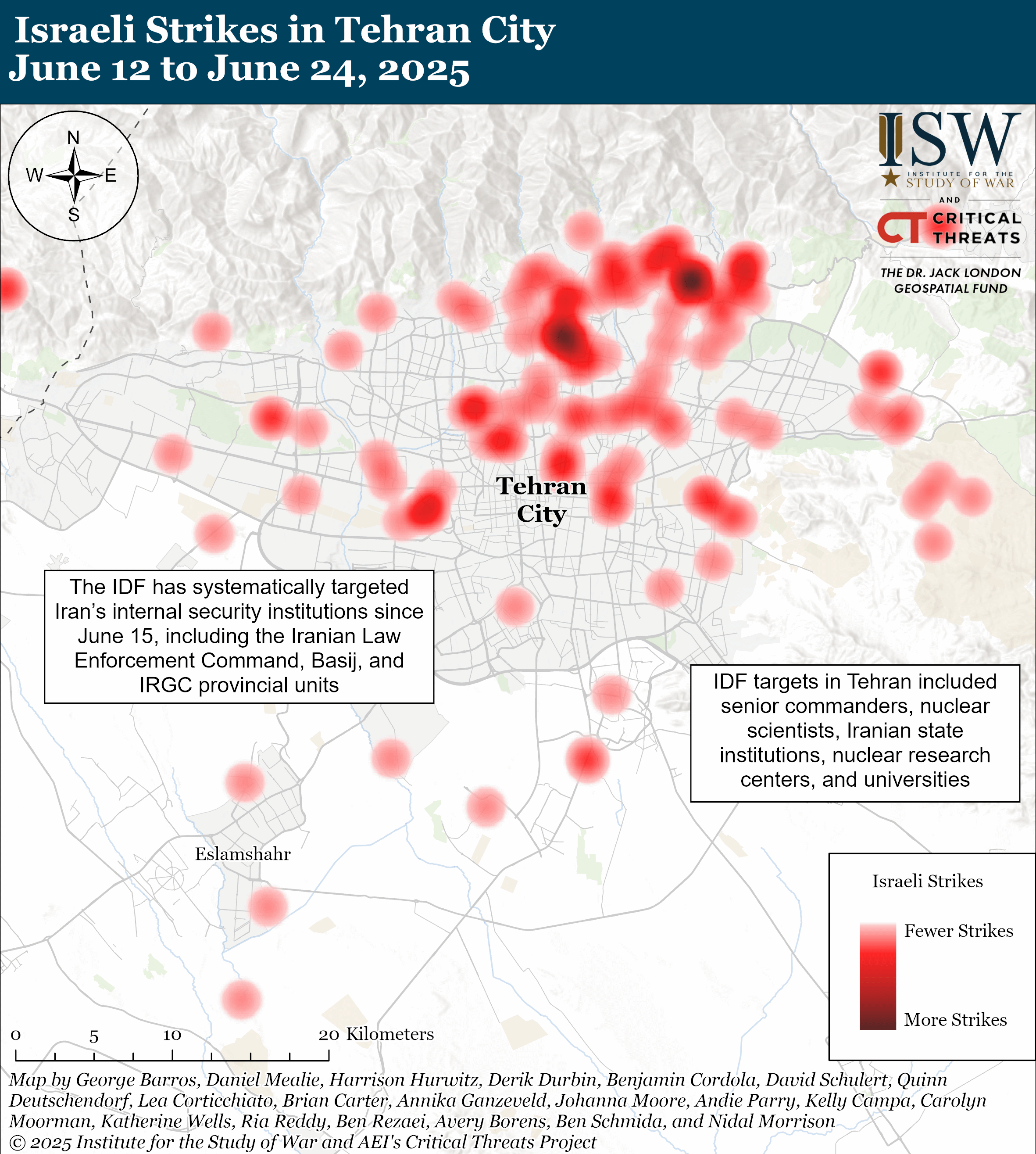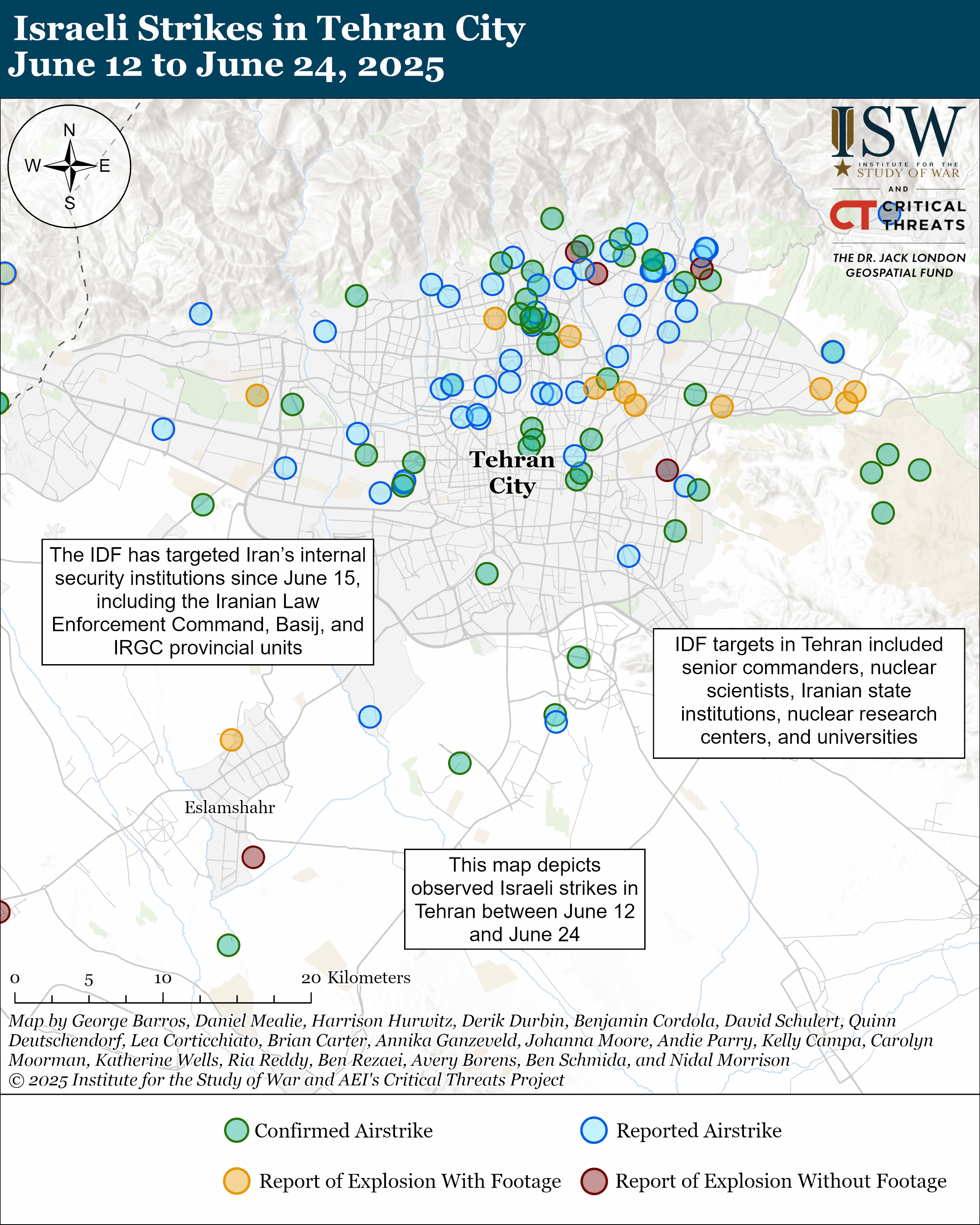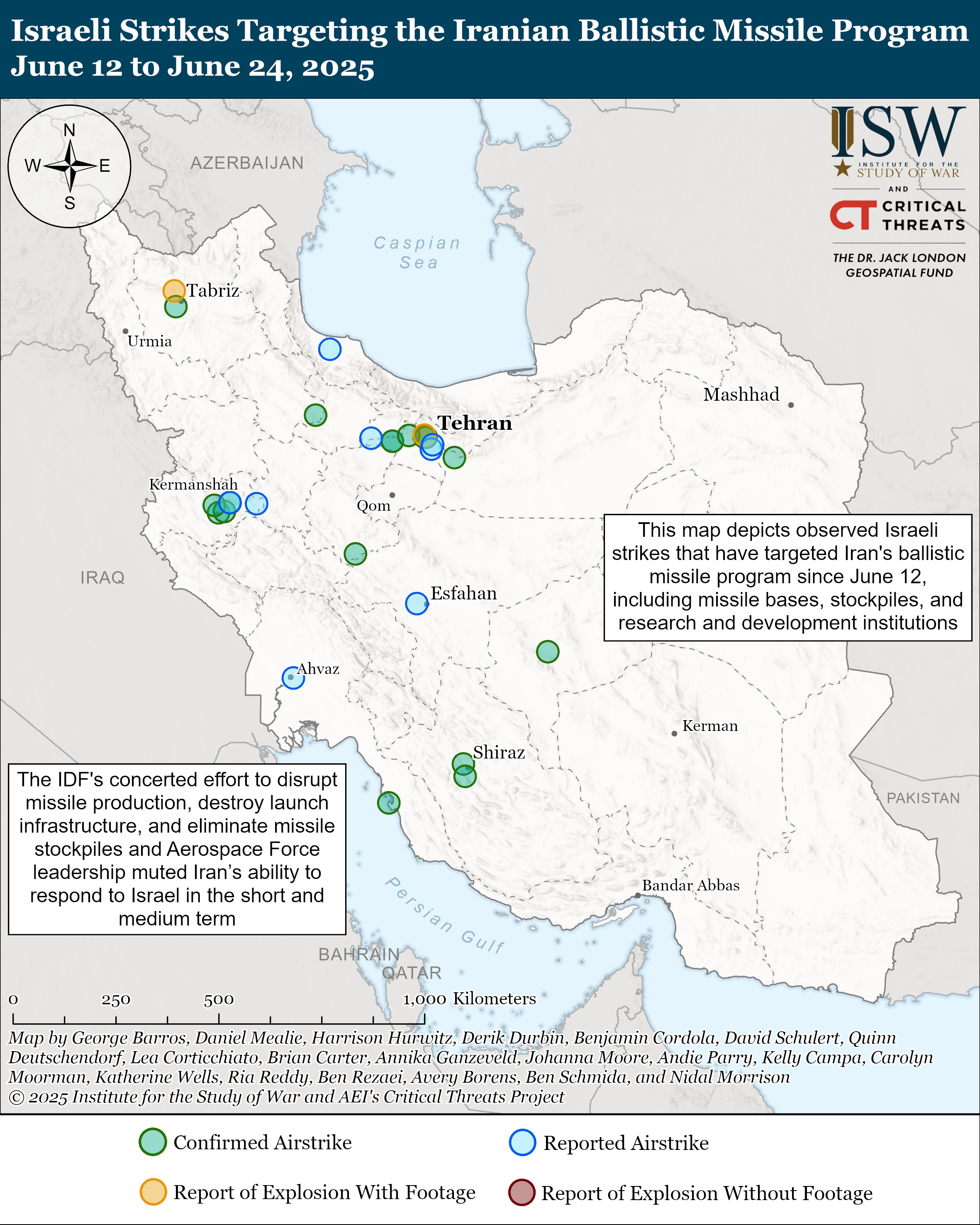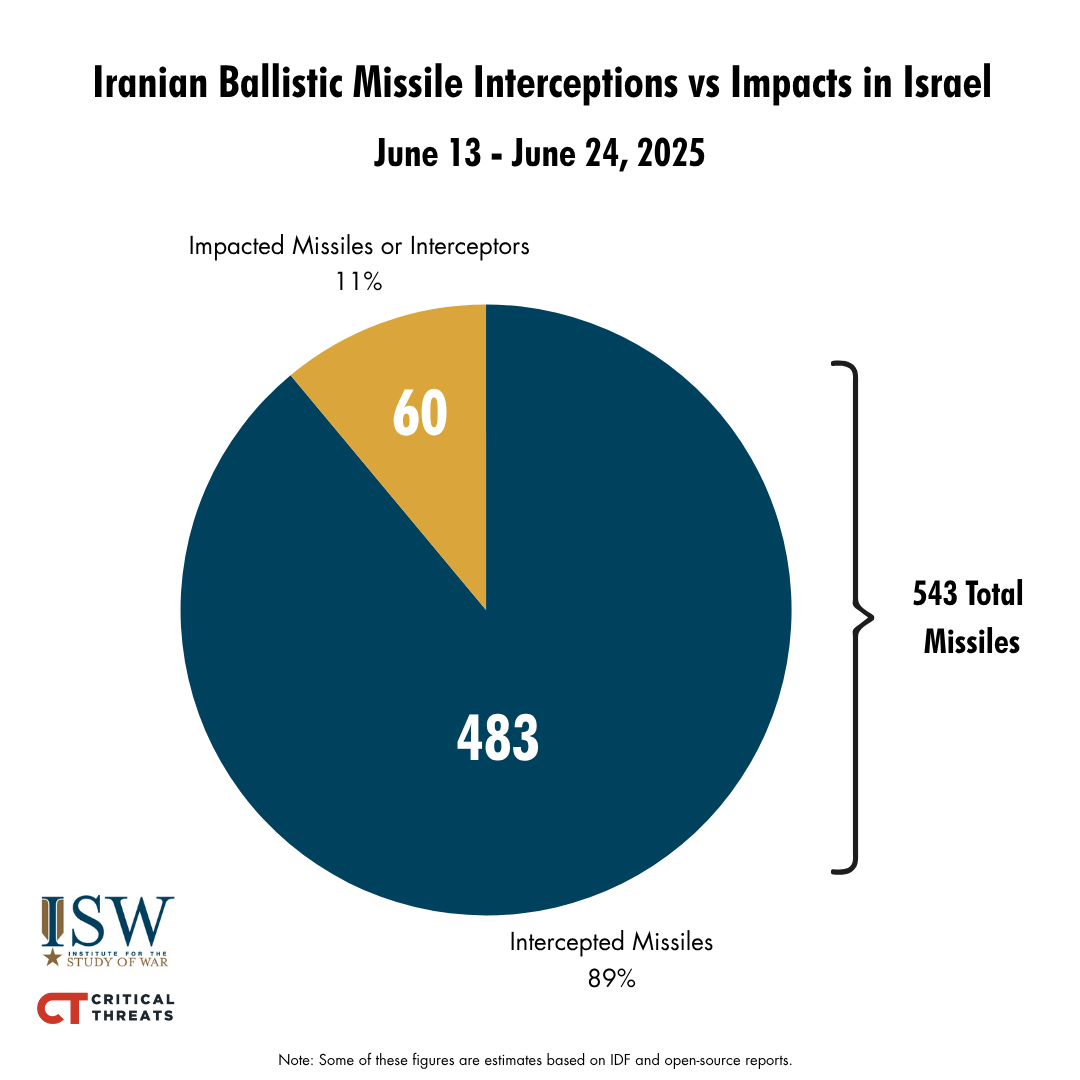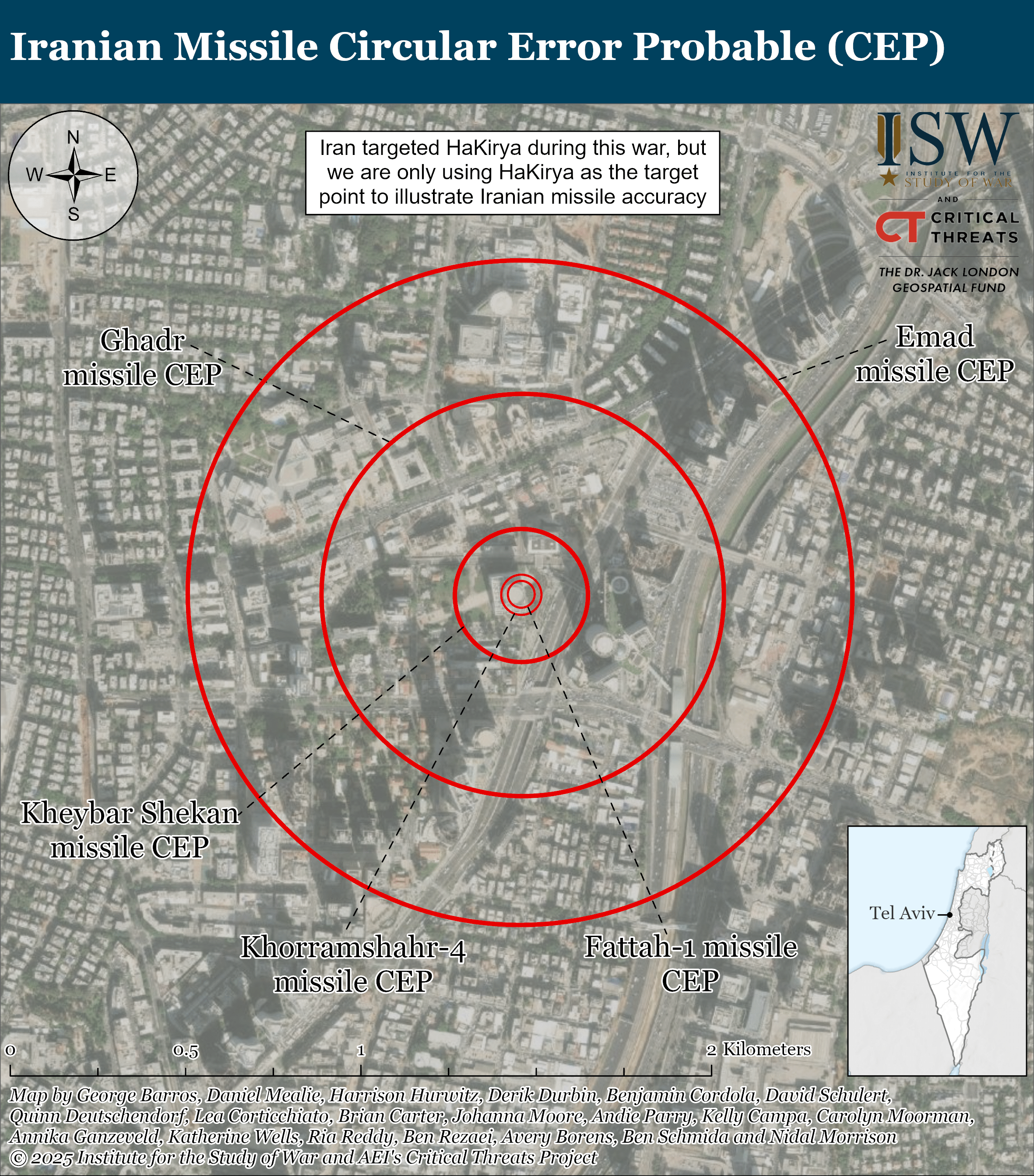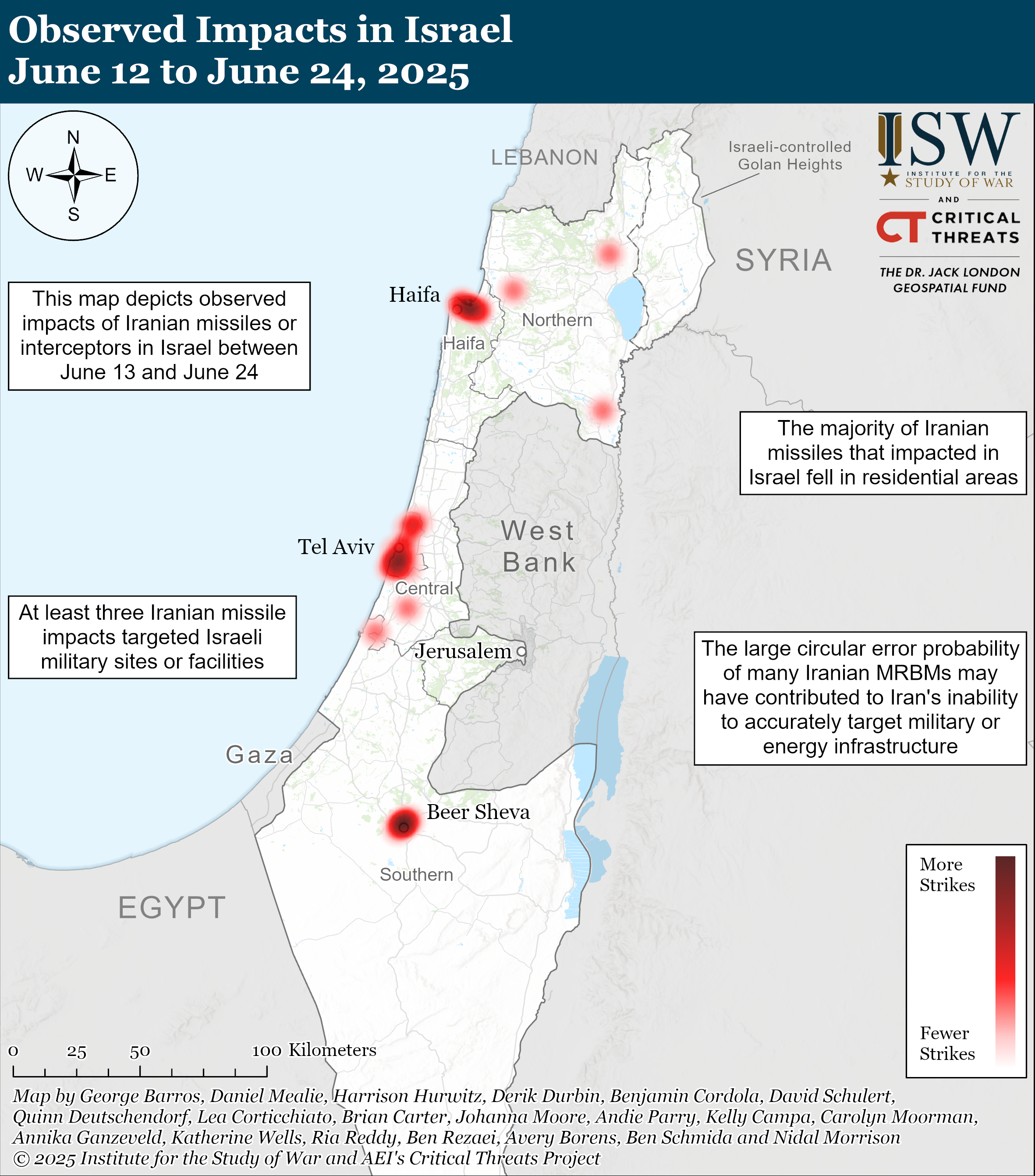{{currentView.title}}
June 23, 2025
Iran Update Special Report, June 24, 2025, Evening Edition
The Critical Threats Project (CTP) at the American Enterprise Institute and the Institute for the Study of War (ISW) are publishing multiple updates daily to provide analysis on the war with Iran. The morning update will focus on the exchange of fire between Iran and Israel. The evening update will be more comprehensive, covering events over the past 24-hour period and refining items discussed in the morning update.
Click here to see ISW-CTP's interactive map showing the total strikes in Iran since June 12, as well as an interactive timelapse showing the strikes day-by-day.
CTP-ISW will not publish a morning update given the ceasefire between Israel and Iran. All analysis of the Israel-Iran war will be covered in the daily evening update unless events warrant a resumption of twice daily updates.
Israel conducted a two-week air campaign with the objective of degrading, destroying and removing the threat of Iran’s nuclear program.[i] Israel also pursued two supporting objectives to limit Iranian retaliation and provide itself with an offramp. Israeli Prime Minister Benjamin Netanyahu stated that “Operation Rising Lion” achieved all of Israel’s war aims “and much more.”[ii] Israel described Iran’s nuclear program as an existential threat to Israel and stated that it would not allow Iran to weaponize its program.[iii] Israel achieved its objectives vis-a-vis the nuclear program by destroying nuclear facilities and enrichment capacity with US support and killing key nuclear scientists who were key in the development and weaponization of the program. The Israeli campaign, supported by US strikes, "effectively destroyed” Iran’s enrichment capacity, though stockpiles of various amounts of enriched uranium remain.[iv] Iran’s ability to enrich these to weapons grade uranium is complicated by the destruction of most of Iran’s centrifuges and the loss of many nuclear scientists.[v] There is more information about the status of the nuclear program below.
Israel supported this main line of effort by conducting a campaign designed to prevent Iran from conducting effective retaliatory strikes on Israel by degrading its ballistic missile capabilities.[vi] Iran originally planned to launch 1,000 ballistic missiles in response to Israeli strikes on Iran, but Israeli strikes forced it to fire much fewer (more on the status of the missile forces below).[vii] Iranian ballistic missile strikes would have targeted Israeli military, intelligence, and political institutions that enabled Israeli operations. These strikes could have also caused major Israeli casualties, which would have been unacceptable for many Israelis. Israeli airstrikes on Iran’s ballistic missile program destroyed Iranian capabilities and forced Iran to launch fewer and smaller attacks on Israel, most of which were intercepted by the IDF.[viii]
Israel pursued a second supporting effort to compel Iran to accept a ceasefire on Israeli terms by creating the perception of a credible existential threat to the Iranian regime. Netanyahu and Israeli Defense Minister Katz directed the IDF on June 20 to “intensify” strikes on Iranian institutions that support regime stability.[ix] The Iranian regime has maintained social control by violently cracking down on protests and other expressions of popular anti-regime sentiment through internal security organizations. Israeli officials suggested that these airstrikes could create conditions which the Iranian population could exploit to overthrow the regime.[x] A series of strikes designed to demonstrate a credible threat to the regime’s stability could be expanded or contracted depending on how the regime responded and Israel’s desire for a ceasefire. Israel could have calculated that the Iranian regime’s overwhelming interest in ensuring regime survival could compel it to agree to a ceasefire.
The limited nature of strikes against internal security institutions suggests that the IDF sought to demonstrate a credible threat to regime stability rather than topple or meaningfully destabilize the regime. A focused, well-designed regime destabilization campaign would have systematically destroyed IRGC provincial and district-level headquarters while simultaneously destroying the Iranian Law Enforcement Command’s infrastructure and assets across the country. Israel struck these targets, but it only did so in Tehran and did not do so systematically even in Tehran.[xi] Israel, given its air superiority over Iran, could have presumably destroyed these targets if needed, which indicates that the IDF made a deliberate choice not to systematically target Iranian internal security assets. The IDF did systematically target missile and nuclear facilities, in contrast.
Israeli strikes against Iran’s energy infrastructure appeared to be related to an effort to influence regime decision-making. Previous energy shortages in Iran have led to protests against the regime. Demonstrations over the rising gas prices in 2017 and 2018 escalated into broader challenges for the regime’s stability, for example.[xii] Israel's attacks on gas production and oil infrastructure, which would exacerbate the root causes of previous demonstrations, suggested that part of Israel’s campaign aimed to influence Iranian regime decision-making by building the perception of a possible credible threat to regime stability. The IDF struck a natural gas processing facility and gas refinery in Bushehr Province on June 14.[xiii] The ensuing fire forced Iranian authorities to partially suspend gas production at South Pars Gas Field, which is one of the largest gas fields in the world and is central to Iran’s domestic energy supply.[xiv] The IDF also struck Iranian oil infrastructure in Tehran on June 14, including an oil depot and an oil refinery in Tehran.[xv] Both the strikes on internal security institutions and energy infrastructure were relatively limited compared to IDF strikes targeting the nuclear program or retaliatory capabilities.
The Institute for Science and International Security assessed that US and Israeli strikes on Iran have “effectively destroyed” Iran’s enrichment program.[xvi] The Institute said it will take a “long time” for Iran to restore its enrichment capabilities to pre-strike levels. This assessment is based on the destruction Iran suffered at Natanz nuclear facility, Fordow nuclear facility, Esfahan Nuclear Technology Center and the elimination of many nuclear scientists.[xvii] The six entry point craters for the US bunker-buster bombs at Fordow were above two weak points, and the bombs would have detonated within the facility.[xviii] The Institute for Science and International Security assesses that the bomb blast would have been channeled by the centrifuge cascade hall’s side walls, which would have destroyed all of the installed centrifuges there.[xix] International Atomic Energy Agency (IAEA) battle damage assessments indicate that Israeli strikes also likely damaged or destroyed several thousand centrifuges at Natanz.[xx] Israel and the United States conducted airstrikes targeting the Pilot Fuel Enrichment Plant above ground and Fuel Enrichment Plant underground at Natanz, respectively.[xxi] The IAEA added that it was possible that uranium isotopes may have been dispersed within the facility (though not outside), which would make it difficult to access.[xxii] This means it may be some time before even the Iranians can determine the true extent of the damage.
The Institute for Science and International Security stated that Iran still retains stockpiles of 3 to 5 percent, 20 percent, and 60 percent enriched uranium, however.[xxiii] Weapons-grade uranium (WGU) is uranium enriched up to 90 percent. The destruction of so many centrifuges will make enriching from 60 percent to 90 percent much slower. A US weapons expert stated that US and Israeli strikes have also made it significantly more difficult and time-consuming for Iran to turn WGU into a usable nuclear weapon.[xxiv] He said the strikes have “significantly” increased the time required for Iran to “even build a non-missile deliverable weapon,“ such as a nuclear bomb. There are significant challenges associated with miniaturizing a nuclear weapon to install it on a ballistic missile warhead.
US President Donald Trump reiterated the US demand for Iran to maintain zero uranium enrichment capabilities.[xxv] Trump stated on June 24 that Iran is “not going to have enrichment and [Iran is] not going to have a nuclear weapon.”[xxvi] He emphasized that “Iran will never rebuild their nuclear facilities.”[xxvii] A senior US official reportedly said the Israel-Iran ceasefire was based on discussions with Iranian officials that indicated Iran is willing to resume nuclear negotiations as long as Israel stop its air campaign.[xxviii] Iranian President Masoud Pezeshkian stated on June 24 that Iran is “ready for talks.”[xxix] Iran repeatedly rejected the US demand for zero uranium enrichment during the US-Iran nuclear negotiations from April to early June 2025.[xxx] It is unclear if Iran is currently willing to accept the US demand for zero uranium enrichment.
Israel has killed at least 14 Iranian nuclear scientists since June 12 as part of its campaign to delay Iran’s ability to weaponize its nuclear capabilities.[xxxi] The IDF killed Sayyed Asghar Hashemi Tabar in Tehran Province on June 20.[xxxii] Hashemi Tabar was a weapons expert at the Shahid Chamran Group, which is a subsidiary of the Iranian Organization of Defensive Innovation and Research (SPND), and specialized in pulse power research.[xxxiii] Pulsed power is a technology that stores and releases energy in intense bursts to simulate nuclear detonation effects for research, but pulsed power does not trigger actual nuclear explosions.[xxxiv] The United States sanctioned the Shahid Chamran Group and Hashemi Tabar in 2019 for research related to Weapon of Mass Destruction (WMD) proliferation.[xxxv] The IDF also killed Iranian nuclear scientist Mostafa Sadati Ermaki in Tehran Province.[xxxvi]
The IDF announced it thwarted a possible Iranian ceasefire violation on June 24 at 4:20 PM ET. The IDF intercepted two drones that it said “apparently" originated from Iran before they entered Israeli airspace.[xxxvii] This attack marks the first time that Iran may have launched drones targeting Israel since the ceasefire went into effect at 12:00 AM ET.[xxxviii] Senior Israeli military and political officials have not commented on the drone attack or threatened a response at the time of this writing.
Key Takeaways
- Israel pursued a campaign to destroy Iran’s nuclear program and with US support was largely successful in doing so. Israel also pursued two supporting lines of effort to limit Iran’s retaliation and create an off-ramp by creating conditions that would pressure Iran into terminating the conflict. Israel pressured Iran by creating a credible threat of regime destabilization.
- The limited nature of strikes against internal security institutions suggests that the IDF sought to demonstrate a credible threat to regime stability rather than topple or meaningfully destabilize the regime. A focused, well-designed regime destabilization campaign would have systematically destroyed regime institutions, which did not happen.
- Iran’s enrichment capabilities have been “effectively destroyed,” according to the Institute for Science and International Security. Iran still retains stockpiles of enriched uranium, but its ability to enrich these stockpiles further will be complicated by the loss of so many centrifuges and facilities.
- Iran’s inability to accurately strike military or energy infrastructure highlights the limited accuracy of its ballistic missiles. The high Israeli intercept rate made it even more difficult for Iran to accurately target key Israeli infrastructure. Israel nonetheless faced sustained missile attacks against key population centers that was unprecedented in the October 7 War.
The IDF has targeted Iran’s internal security institutions, including the Iranian Law Enforcement Command (LEC), Basij, and IRGC provincial units since June 15.[xxxix] Israeli strikes on regime security institutions continued on June 23 before the ceasefire. Israeli Defense Minister Israel Katz announced on June 20 that he ordered “intensified” strikes on regime symbols and domestic repression centers in Tehran Province.[xl] The IDF struck the IRGC Imam Hassan Mojtaba Corps headquarters in Alborz Province on June 23 and killed at least 23 IRGC members, including Provincial Deputy Commander Brigadier General Mojtaba Karami and Deputy for Social Affairs Brigadier General Akbar Enayati.[xli]
The IDF also killed three senior security and intelligence commanders on June 23, including Deputy for social affairs of the Basij Organization Brigadier General Meysam Rezvanpour, LEC Intelligence Organization Deputy Brigadier General Alireza Lotfi and Basij Counterintelligence Commander Mohammad Taghi Yousefvand, likely to degrade the regime’s security and intelligence infrastructure.[xlii] The Iranian regime has maintained social control by violently cracking down on protests and other expressions of popular anti-regime sentiment through internal security organizations like the Basij, LEC, and the IRGC.[xliii] Basij units have been deployed to support LEC forces during major protest movements like the Mahsa Amini protests and the Iranian Green Movement.[xliv]
IRGC Quds Force Commander Brigadier General Esmail Ghaani appeared at a rally in Tehran Province on June 24.[xlv] A New York Times reporter claimed on June 13 that Israeli strikes killed Ghaani along with other senior IRGC commanders.[xlvi]
IDF Campaign Against Iran’s Ballistic Missile Forces
The IDF sought to limit Iran’s ability to respond to Israel at the start of its campaign and continued to destroy Iranian missile launchers and stockpiles throughout the air campaign. Iranian leaders originally planned to launch up to one thousand ballistic missiles at Israel in the immediate aftermath of an Israeli strike, presumably in multiple barrages.[xlvii] The first Iranian missile barrage included about 30 missiles, and Iran never managed to launch over 40 ballistic missiles in a single barrage throughout the 12 days of attacks.[xlviii] Israel reportedly built a secret one-way attack drone base in Iran, which it used to strike Iranian ballistic missile launchers near Tehran on June 12.[xlix] Israel also targeted a meeting of senior IRGC Aerospace commanders who would have been responsible for giving the order to attack immediately after the strike.[l] The IDF Air Force proceeded to strike Iranian ballistic missile launchers as they were readied to launch and in warehouses at a consistent and daily tempo throughout the campaign.[li] Israel has also targeted Iranian missile production sites and equipment, including planetary mixers used to produce solid fuel for long-range ballistic missiles.[lii] Israel’s concerted effort to disrupt missile production, destroy launch infrastructure, and eliminate missile stockpile and Aerospace Force leadership muted Iran’s ability to respond to Israel in both the short and medium term.
The IDF assessed that Iran launched between 500 and 550 ballistic missiles and more than 1,000 drones targeting Israel during its “Operation True Promise III.”[liii] The IDF’s assessment is consistent with CTP-ISW's observation of 543 Iranian ballistic missiles. CTP-ISW has recorded 43 waves of Iranian ballistic missile attacks targeting Israel since the start of “Operation True Promise III” on June 13. Iran’s ballistic missile barrages during “Operation True Promise III” varied in size. Iran used around 40 missiles in its largest barrage and one missile in its smallest barrage.[liv] Iran’s missile barrages in the recent conflict are much smaller compared to its barrages in its October 2024 attack on Israel when Iran launched around 100 ballistic missiles per barrage in two barrages.[lv] An Israeli Army Radio correspondent reported on June 24 that Israeli air defense systems successfully intercepted 80 to 90 percent of Iran’s ballistic missiles.[lvi] Israel also reportedly had a 99.99 percent interception rate of Iranian drones, with only one drone making impact.[lvii]
Israeli air defenses maintained a high intercept rate against Iranian ballistic missile attacks during the war. Israeli air defense systems have successfully intercepted 89 percent of Iranian ballistic missiles launched at Israel since June 12. Israeli air defenses did not intercept Iranian ballistic missiles on trajectory to strike areas with no risk to Israeli civilians or no strategic value.[lviii] Air defense systems and their operators prioritize incoming projectiles that will hit targets of significance rather than attempting to stop every projectile. Missile strikes in open areas are not indicative of Israeli air defense failures or a shortage of interceptor missiles but rather Israel’s defensive priorities. Israeli air defenses have previously prioritized defending highly populated areas as seen during Iran’s October 2024 missile attack.[lix] Iranian ballistic missiles did penetrate Israeli air defenses striking populated areas in some instances, however. Air defense systems are not perfect, and some projectiles will penetrate the system.[lx]
Iranian ballistic missiles do not have pinpoint accuracy. Iran’s inability to accurately strike military or energy infrastructure highlights the limited accuracy of its ballistic missiles. All ballistic missiles have a circular error probable (CEP). The CEP is “the radius of a circle, centered at the intended target, within which 50% of the missiles would be expected to impact.”[lxi] The stated and publicly known CEPs of Iranian medium-range ballistic missiles (MRBMs) used in this war are between 20 and 500 meters.[lxii] The relatively poor accuracy of these missiles compared to a precision guided munition means that even in instances when Iranian missiles struck military targets, they were largely ineffective and caused no casualties and limited damage. Iran targeted an Israeli military intelligence facility during the war with four missiles, and three of the four completely missed the base while the fourth struck a warehouse on the outskirts of the compound.[lxiii] This case demonstrates the futility of using these missiles against pinpoint military targets, which may explain the increased focus on civilian targets during this war. Iran likely began using cluster warheads--ballistic missile warheads with hundreds of submunitions--to maximize the potential impact of its ballistic missiles given their relatively low accuracy when fitted with standard warheads. [lxiv]
Iran used several solid- and liquid-fuel MRBMs, including Ghadr, Emad, Kheybar Shekan, and Haj Qassem missiles.[lxv] Iran previously used the Ghadr, Emad, and Kheybar Shekan missiles during its April and October 2024 attacks on Israel.[lxvi] Iran began using more technologically advanced missiles in its attacks on June 18.[lxvii] Iran launched at least three missiles with cluster munition warheads, including two Khorramshahr-4 missiles.[lxviii] Iran reportedly launched a Sejjil ballistic missile and several Fattah-1 missiles (which the Houthis have fired at Israel under the name Palestine-2) towards Israel on June 18.[lxix] The Islamic Revolutionary Guard Corps (IRGC) said on June 22 that it ”employed new tactics using a mix of long-range liquid- and solid-fuel ballistic missiles with advanced warheads capable of penetrating air defenses.”[lxx] Iran also launched a variety of drones, including the Shahed-136, Arash-2, and an enlarged version of the Shahed-101.[lxxi]
CTP-ISW has recorded 60 Iranian ballistic missile or Israeli interceptor impacts in Israel from over 40 Iranian barrages since the Israeli air campaign began on June 12. This estimate is consistent with an Israeli Army Radio correspondent’s assessment that between 50 and 60 Iranian ballistic missiles struck Israeli territory.[lxxii] Iranian ballistic missile impacts killed 28 people in Israel, including one IDF soldier.[lxxiii] The majority of Iranian missiles struck civilian areas with only five out of the 60 impacts striking military or energy infrastructure facilities.[lxxiv] At least three Iranian missile impacts targeted Israeli military sites or facilities. One Iranian ballistic missile struck near HaKirya in Tel Aviv on June 13.[lxxv] Another Iranian ballistic missile struck a warehouse near the Military Intelligence School in Camp Moshe Dayan on June 17.[lxxvi] An Iranian ballistic missile also struck the Gav Yem Negev Advanced Technologies Park which houses active military and cyber facilities.[lxxvii] At least two Iranian missile impacts targeted Israeli energy infrastructure. Iranian ballistic missiles struck the Bazan Oil refinery in Haifa on June 15, which caused the facility to temporarily shut down.[lxxviii] An Iranian ballistic missile struck an electrical substation in Ashdod on June 23.[lxxix]
No group has claimed responsibility for the drone attacks that targeted Ain al Asad Airbase and Baghdad International Airport overnight on June 23 and 24 since CTP-ISW's last data cutoff at 08:00 AM on June 24. The United States intercepted both drones.[lxxx] A third drone crashed in al Radwaniyah, Anbar Province, about seven kilometers south of the airport.[lxxxi] Iranian-backed Iraqi militias have previously attacked both Ain al Asad Airbase and the airport.[lxxxii] Multiple Iranian-backed Iraqi militias threatened prior to the US strikes on Iranian nuclear sites that the militias would target the United States and its regional interests if the United States entered the war.[lxxxiii]
Drone attacks targeting Camp Taji, Baghdad Province, and Imam Ali Air Base, Dhi Qar Province, on June 23 “severely damaged” Iraqi radars at those sites, according to Iraqi Prime Minister Mohammad Shia al Sudani’s spokesperson.[lxxxiv] No group has claimed responsibility for these attacks at the time of this writing. Sudani ordered the formation of a high-level committee to investigate the attacks. These attacks follow Iranian-backed Iraqi figures repeatedly condemning Israel’s use of Iraqi airspace to strike Iran.[lxxxv]
[i] https://x.com/manniefabian/status/1933420882162016634
[ii] https://x.com/idfonline/status/1937548580178248104 ; https://x.com/IsraeliPM/status/1937407518667350282
[iii] https://x.com/manniefabian/status/1933420882162016634
[iv] https://isis-online.org/isis-reports/post-attack-assessment-of-the-first-12-days-of-israeli-strikes-on-iranian-nuclear-facilities
[v] https://isis-online.org/isis-reports/post-attack-assessment-of-the-first-12-days-of-israeli-strikes-on-iranian-nuclear-facilities
[vi] https://x.com/manniefabian/status/1936394722731229432
[vii] https://www.nytimes.com/2025/06/13/world/middleeast/iran-israel-strikes-nuclear-talks.html
[viii] https://x.com/manniefabian/status/1936394722731229432
[ix] https://www.timesofisrael dot com/liveblog_entry/katz-says-he-instructed-idf-to-destabilize-iranian-regime-with-intensified-strikes-against-it/
[x] https://www.pbs.org/newshour/show/regime-change-in-iran-seems-unlikely-amid-war-with-israel-middle-east-scholar-says
[xi] https://understandingwar.org/backgrounder/iran-update-special-report-june-20-2025-morning-edition ; https://understandingwar.org/backgrounder/iran-update-special-report-june-18-2025-evening-edition
[xii] https://apnews.com/article/208de9a8f9e64d32b3be2d98aa95e265 ;
https://www.reuters.com/article/world/special-report-irans-leader-ordered-crackdown-on-unrest-do-whatever-it-take-idUSKBN1YR0QO/
[xiii] https://www.bloomberg.com/news/articles/2025-06-14/israel-strikes-refinery-at-iran-s-giant-south-pars-gas-field ; https://www.tasnimnews dot com/fa/news/1404/03/24/3335396
[xiv] https://www.offshore-technology.com/news/south-pars-gas-field-disruption-after-israeli-strike; https://www.tasnimnews dot com/fa/news/1404/03/24/3335380
[xv] https://x.com/manniefabian/status/1933992562794078642; https://www.nytimes.com/2025/06/14/world/middleeast/iran-israel-energy-facility-strikes-tehran.html
[xvi] https://isis-online.org/isis-reports/post-attack-assessment-of-the-first-12-days-of-israeli-strikes-on-iranian-nuclear-facilities ; https://x.com/DAVIDHALBRIGHT1/status/1937556394766450949
[xvii] https://isis-online.org/isis-reports/post-attack-assessment-of-the-first-12-days-of-israeli-strikes-on-iranian-nuclear-facilities ; https://x.com/TheGoodISIS/status/1937547337917669404
[xviii] https://isis-online.org/isis-reports/post-attack-assessment-of-the-first-12-days-of-israeli-strikes-on-iranian-nuclear-facilities
[xix] https://isis-online.org/isis-reports/post-attack-assessment-of-the-first-12-days-of-israeli-strikes-on-iranian-nuclear-facilities ; https://x.com/TheGoodISIS/status/1937547337917669404
[xx] https://www.iaea.org/newscenter/statements/iaea-director-general-grossis-statement-to-unsc-on-situation-in-iran ; https://x.com/iaeaorg/status/1936097757682389170
[xxi] https://www.iaea.org/newscenter/statements/iaea-director-generals-introductory-statement-to-the-board-of-governors-23-june-2025 ; https://x.com/TheGoodISIS/status/1933539314148823467
[xxii] https://www.iaea.org/newscenter/pressreleases/update-on-developments-in-iran-6
[xxiii] https://isis-online.org/isis-reports/post-attack-assessment-of-the-first-12-days-of-israeli-strikes-on-iranian-nuclear-facilities ; https://x.com/DAVIDHALBRIGHT1/status/1937556394766450949
[xxiv] https://x.com/DAVIDHALBRIGHT1/status/1937556394766450949
[xxv] https://x.com/RapidResponse47/status/1937519347213222016
[xxvi] https://x.com/RapidResponse47/status/1937519347213222016
[xxvii] https://x.com/TrumpDailyPosts/status/1937490949816320259
[xxviii] https://x.com/John_Hudson/status/1937320919711535199
[xxix] https://www.cnn.com/world/live-news/israel-iran-conflict-us-trump-06-24-25-intl-hnk#cmcak7i80001s3b6qegh8qptj
[xxx] https://x.com/araghchi/status/1925669240461213916 ; https://www.reuters.com/world/iran-us-resume-nuclear-talks-amid-clashing-red-lines-2025-05-11/
[xxxi] https://apnews.com/article/israel-iran-nuclear-science-attacks-e298f00ba261debba4499a48c9df8b3d
[xxxii] https://www.ynetnews dot com/article/8a41u7di2
[xxxiii] https://www.iranwatch.org/iranian-entities/sayyed-asghar-hashemitabar
[xxxiv] https://www.sandia.gov/z-machine/#:~:text=The%20Sandia%20Z%2DMachine,Photo%20by%20Randy%20Montoya. ;
https://unterm.un.org/unterm2/en/view/8a49673e-a407-4536-b716-f43b32196803 ;
[xxxv] https://sanctionssearch.ofac.treas.gov/Details.aspx?id=26571 ; https://home.treasury.gov/news/press-releases/sm634
[xxxvi] https://www.tehrantimes dot com/news/514851
[xxxvii] https://x.com/idfonline/status/1937606821746987073
[xxxviii] https://www.understandingwar.org/backgrounder/iran-update-special-report-june-24-2025-morning-edition
[xxxix] https://x.com/manniefabian/status/1935993942798930397 ;
[xl] https://x.com/manniefabian/status/1935993942798930397 ; https://x.com/IDFFarsi/status/1936009764791542142
[xli] https://www.tasnimnews dot com/fa/news/1404/04/03/3341488 ;
https://x.com/vvanwilgenburg/status/1937432155228885300 ;
https://www.tasnimnews dot com/fa/news/1404/04/03/3341747/
[xlii] https://vista dot ir/n/fararu-skhzj ;
https://www.tasnimnews dot com/fa/news/1404/04/03/3341740 ;
https://snn dot ir/fa/news/1277712
[xliii] https://www.criticalthreats.org/wp-content/uploads/2021/12/Whatever-it-takes-to-end-it.pdf
[xliv] https://www.criticalthreats.org/wp-content/uploads/2021/12/Whatever-it-takes-to-end-it.pdf ; https://apnews.com/article/iran-middle-east-577c596775fb9a78d78107004d29d0f9
[xlv] https://x.com/PressTV/status/1937583870863638617
[xlvi] https://x.com/farnazfassihi/status/1933550127937171804
[xlvii] https://www.nytimes.com/2025/06/13/world/middleeast/iran-israel-strikes-nuclear-talks.html
[xlviii] https://x.com/JoeTruzman/status/1933388672285749376 ; https://x.com/idfonline/status/1933462941157806557 ; https://x.com/manniefabian/status/1933411643087585730 ; https://x.com/manniefabian/status/1934146552152359084
[xlix] https://x.com/idfonline/status/1933441868211126675 ; https://x.com/manniefabian/status/1933455569429357026 ; https://x.com/chawshin_83/status/1933431758160011480 ; https://www.axios.com/2025/06/13/how-israel-executed-strike-iran-nuclear
[l] https://www.nytimes.com/2025/06/13/world/middleeast/iran-israel-strikes-nuclear-talks.html
[li] https://x.com/idfonline/status/1937376287875551332 ; https://x.com/idfonline/status/1937236971648418063 ; https://x.com/idfonline/status/1937129274370089263 ; https://x.com/idfonline/status/1937033234371538966 ; https://x.com/idfonline/status/1936885128245940475 ;
[lii] https://x.com/manniefabian/status/1936841741971103989
[liii] https://x.com/Doron_Kadosh/status/1937525138087448600
[liv] https://x.com/manniefabian/status/1934146552152359084 ; https://x.com/manniefabian/status/1937075231182438832
[lv] https://www.understandingwar.org/backgrounder/iran-update-october-1-2024
[lvi] https://x.com/Doron_Kadosh/status/1937525138087448600
[lvii] https://x.com/Doron_Kadosh/status/1937525138087448600
; https://www.nbcnews.com/video/iranian-missile-hits-bus-terminal-north-of-tel-aviv-241733701889
[lix] https://www.understandingwar.org/backgrounder/iran-update-october-1-2024
[lx] https://www dot inss.org.il/social_media/the-israel-iran-war-air-defense-performance/
[lxi] https://digitalcommons.usu.edu/etd/6805/#:~:text=The%20Department%20of%20Defense%20has%20places%20emphasis,or%20%22The%20probability%20is%200.50%20that%20an
[lxii] https://www.iranwatch.org/our-publications/weapon-program-background-report/table-irans-missile-arsenal#fn6
[lxiii] https://www.understandingwar.org/backgrounder/iran-update-special-report-june-17-2025-evening-edition ; https://x.com/FaytuksNetwork/status/1934897791416844608
[lxiv] https://www.washingtonpost.com/world/2024/04/17/iran-israel-attack-drones-missiles/ ; https://www.tasnimnews dot com/fa/news/1404/01/06/3281426 ; https://defapress dot ir/fa/news/718877 ; https://www.criticalthreats.org/analysis/iran-update-april-13-2024 ; https://www.criticalthreats.org/analysis/iran-update-october-1-2024
[lxv] https://www.twz.com/land/iran-just-used-ballistic-missiles-with-cluster-warheads-to-strike-israel ; https://www.euronews.com/2025/06/22/iranian-weapon-with-ideological-payload-what-is-the-kheibar-shekan-missile ; https://www.kurdistan24 dot net/en/story/845868/iran-uses-new-missile-named-after-qassem-soleimani-in-attack-on-israel
[lxvi] https://www.washingtonpost.com/world/2024/04/17/iran-israel-attack-drones-missiles/ ; https://www.tasnimnews dot com/fa/news/1404/01/06/3281426 ; https://defapress dot ir/fa/news/718877 ; https://www.criticalthreats.org/analysis/iran-update-april-13-2024 ; https://www.criticalthreats.org/analysis/iran-update-october-1-2024
[lxvii] https://www.understandingwar.org/backgrounder/iran-update-special-report-june-19-2025-evening-edition
[lxviii] https://x.com/ariel_oseran/status/1935703221961392613 ; https://x.com/ariel_oseran/status/1936784300067750322 ; https://t.me/moriahdoron/23373
[lxix] https://www.pbs.org/newshour/world/why-hypersonic-missiles-are-stirring-fears-in-the-conflict-between-israel-and-iran ; https://www.tasnimnews dot com/en/news/2025/06/19/3338126/iran-s-operation-true-promise-iii-israel-attacked-with-sejjil-missiles-for-first-time
[lxx] https://x.com/JoeTruzman/status/1936658785919172754
[lxxi] https://www.iiss.org/online-analysis/online-analysis/2025/06/israels-attack-and-the-limits-of-irans-missile-strategy/
[lxxii] https://x.com/Doron_Kadosh/status/1937525138087448600
[lxxiii] https://x.com/Doron_Kadosh/status/1937525138087448600
[lxxiv] https://edition.cnn.com/2025/06/14/world/video/missile-strike-kirya-israel-military-digvid ; https://www.understandingwar.org/backgrounder/iran-update-special-report-june-17-2025-evening-edition ; https://www.understandingwar.org/backgrounder/iran-update-special-report-june-20-2025-evening-edition ; https://www.middleeasteye.net/news/iran-strikes-technology-square-israel-microsoft-building-damaged ; https://x.com/andynovy/status/1937057924381102573
[lxxv] https://edition.cnn.com/2025/06/14/world/video/missile-strike-kirya-israel-military-digvid
[lxxvi] https://www.understandingwar.org/backgrounder/iran-update-special-report-june-17-2025-evening-edition
[lxxvii] https://www.understandingwar.org/backgrounder/iran-update-special-report-june-20-2025-evening-edition ; https://www.middleeasteye.net/news/iran-strikes-technology-square-israel-microsoft-building-damaged ; https://www.understandingwar.org/backgrounder/iran-update-special-report-june-16-2025-evening-edition
[lxxviii] https://www.understandingwar.org/backgrounder/iran-update-special-report-june-16-2025-evening-edition
[lxxix] https://x.com/andynovy/status/1937057924381102573
[lxxx] https://apnews.com/article/israel-iran-trump-ceasefire-attacks-continue-f1e60190722cc3410b69f21717872ffa
[lxxxi] https://www.alsumaria dot tv/news/security/531043/بالصورة-بقايا-طائرة-مسيرة-في-الرضوانية
[lxxxii] https://www.washingtoninstitute.org/policy-analysis/tracking-anti-us-and-anti-israel-strikes-iraq-and-syria-during-gaza-crisis ; https://x.com/USAmbIraq/status/1841107559576449043
[lxxxiii] https://t.me/abualaskary/134 ; https://www.understandingwar.org/backgrounder/iran-update-special-report-june-19-2025-evening-edition
[lxxxiv] https://www.shafaq dot com/ar/أمـن/العراق-يعلن-التصدي-لطا-رات-انتحارية-مسي-رة-خرقت-اجوا-ه
[lxxxv] https://t.me/Al_Nojaba/1274 ; https://www.alahad dot iq/?page=article&itemId=227367 ; https://x.com/aboalaa_alwalae/status/1934724552795254855/photo/1
